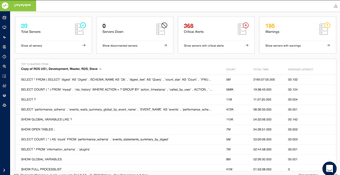Video : SQL Diagnostic Manager for MySQL
High Availability and Scalability with Galera Cluster for MySQL
High availability is crucial for MySQL databases because it ensures that data is always accessible, which is a top priority for any organization. Downtime, even for a few minutes, can cause significant loss of revenue and reputation. High availability systems provide quick recovery of all system components to minimize downtime and maintain user satisfaction. By implementing high availability solutions such as MySQL InnoDB Cluster, developers, architects, and DBAs can manage and maintain continuous access to their databases.
Scalability is important for MySQL databases because it allows the system to accommodate an increase in user, query, and data loads without compromising performance. As the database grows, it is essential to maintain efficient operations and meet the demands of expanding applications or user bases. Scalability ensures that the database can handle growth in a cost-effective manner, preventing the need for expensive hardware upgrades or complete system overhauls. By optimizing data types, reviewing indexes, and implementing horizontal scaling strategies, MySQL databases can achieve higher levels of scalability and continue to deliver optimal performance as the system grows.
Galera Cluster for MySQL is a synchronous multiple-master database cluster, based on synchronous replication and MySQL and InnoDB. It is a true multiple-master cluster that provides an easy-to-use, high-availability solution, ensuring high system uptime, no data loss, and scalability for future growth. When Galera Cluster is in use, the database reads and writes can be directed to any node, and any individual node can be lost without interruption in operations and without using complex failover procedures. Galera Cluster also offers good cloud support and performs well in various cloud environments, making it suitable for elastic scale-out and scale-in operations.
Watch this video to learn how Galera Cluster provides high availability and scalability for MySQL databases.
See Also:
- Webcast: What’s New in SQL Diagnostic Manager for MySQL 8.9
- Datasheet: Monitor MySQL Performance with SQL Diagnostic Manager for MySQL
- Datasheet: Monitor SQL Server Performance with SQL Diagnostic Manager for SQL Server
- Datasheet: SQL Diagnostic Manager for MySQL
- Video: An Overview of SQL Diagnostic Manager for MySQL
- Video: Why Use SQL Diagnostic Manager for MySQL
- Video: Achieve Faster Issue Resolution Time for MySQL and MariaDB with SQL Diagnostic Manager
- Video: Audit Log Analysis for MySQL and MariaDB Databases with SQL Diagnostic Manager
- Video: Become Better at Monitoring MySQL and MariaDB Databases with SQL Diagnostic Manager
- Video: Introduction to SQL Diagnostic Manager for MySQL
- Video: Monitoring Amazon RDS for MySQL and MariaDB with SQL Diagnostic Manager: Beyond Raw Logs
- Video: MySQL Performance Tuning with SQL Diagnostic Manager
- Video: MySQL Performance Tuning with SQL Diagnostic Manager – Part 1 of 4
- Video: MySQL Performance Tuning with SQL Diagnostic Manager – Part 2 of 4
- Video: MySQL Performance Tuning with SQL Diagnostic Manager – Part 3 of 4
- Video: MySQL Performance Tuning with SQL Diagnostic Manager – Part 4 of 4
- Video: Real-time MySQL Monitoring and RDS File-based Log Monitoring with SQL Diagnostic Manager
Topics : Database Diagnostics,Database Monitoring,Database Performance,SQL Query Performance,
Products : SQL Diagnostic Manager for MySQL,

